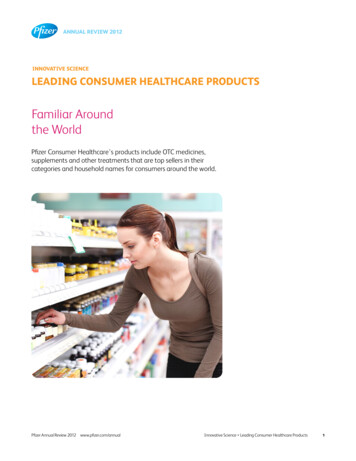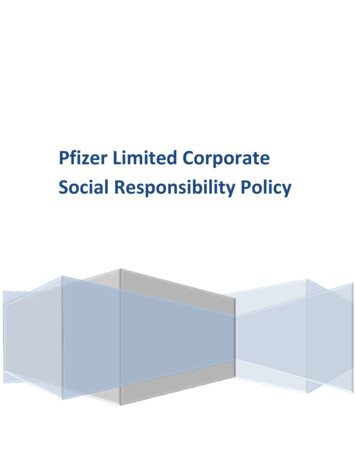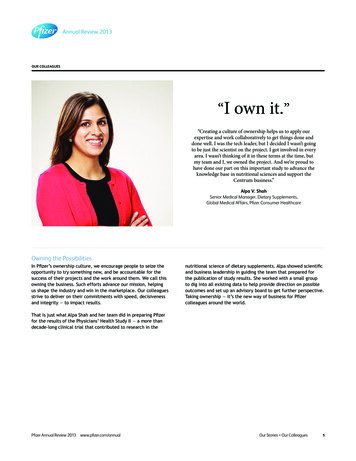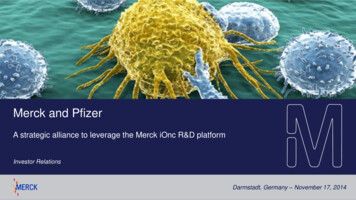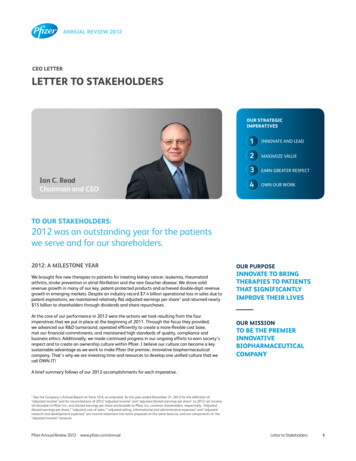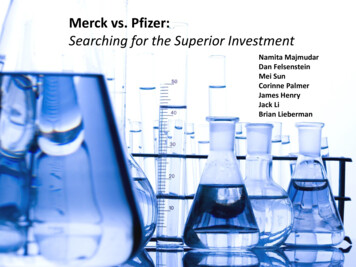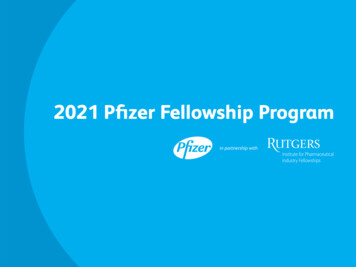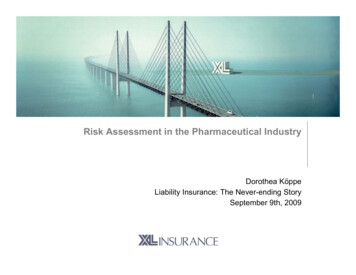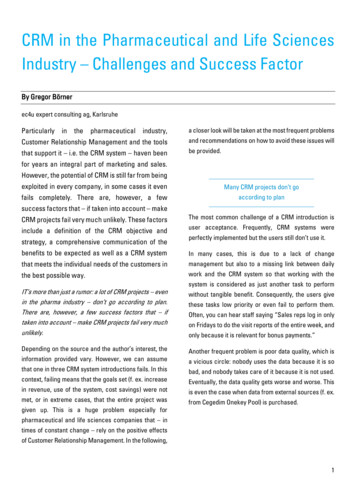
Transcription
STRATEGIC REPORT FORPFIZER PHARMACEUTICAL COMPANYCOREY VAN DER WALELIHU BOGANADAM HENRYApril 18, 2007
TABLE OF CONTENTSEXECUTIVE SUMMARY.3COMPANY BACKGROUND.4COMPETITIVE ANALYSIS.5INTERNAL RIVALRY.BARRIERS TO ENTRY AND EXIT .SUBSTITUTES AND COMPLEMENTS.SUPPLIER POWER.BUYER POWER.67899FIVE FORCES SUMMARY .10FINANCIAL ISSUES.10AT A GLANCE.STOCK PERFORMANCE .DUPONT ANALYSIS .DISCOUNTED CASH FLOW ANALYSIS.SWOT ANALYSIS.1011121314STRATEGIC ISSUES.15ISSUE #1.ISSUE #2 .RECOMMENDATIONS.151718RECOMMENDATION 1.RECOMMENDATION 2 .RECOMMENDATION 3.RECOMMENDATION 4.HOW RECOMMENDATIONS ALLEVIATE ISSUES .EXHIBITS .1922232526292
EXECUTIVE SUMMARYPfizer (Ticker Symbol: PFE) is the world’s largest research-based pharmaceuticalcompany with a market capitalization approaching 200 billion USD. TheCompany produces drugs which address nearly every kind of human and animalailment imaginable. Pfizer researches, develops, produces, markets and sells itsproducts. The Company divides its product line into three distinct groups: humanhealth, consumer healthcare and animal health.The top products by revenue and volume produced by the human health groupinclude Lipitor (for cholesterol), Norvasc (for hypertension and angina), Zoloft(for depression), Celebrex (for arthritis) and Viagra (for erectile dysfunction).Lipitor is the world’s highest revenue-generating prescription medicine. e-countermedications as Listerine, Nicorette, Benadryl, Sudafed, Visine, Purell andBenGay. The animal health division produces various products includingparasiticides, anti-inflammatories, vaccines and antibiotics. Pfizer’s humanhealth group accounts for the lion’s share of the Company’s revenues (93% in2006).Pfizer is a truly international company. While the Company is based in New YorkCity and earned 53.4% of its fiscal 2006 revenues1 in the U.S., the Company has79 plants and locations spread across the globe2. The Company’s major facilitiesoutside of the U.S. are in Belgium, Brazil, France, Germany, Ireland, Italy, Japan,Mexico, Puerto Rico, Singapore, Sweden and the UK.This paper reviews Pfizer’s history, examines the forces at play in thepharmaceutical industry as a whole and provides a high level financial analysis ofthe Company. This report uses these three areas of research to identify two majorstrategic issues facing Pfizer today and recommends four solutions Pfizer canimplement to meet these challenges.12Pfizer 2006 10-K Financial ReportIbid3
COMPANY BACKGROUNDToday’s global behemoth Pfizer finds its modest beginnings in a brick building inBrooklyn, New York in 1849. Using 2,500 borrowed from his father, CharlesPfizer founded Charles Pfizer & Co. with his cousin Charles Erhart. The cousinswere young entrepreneurs from Germany who wanted to bring chemicals notfound in the US to the American marketplace. The first product the Companymade was a candy cone, created by combining Santonin (an anthelmintic, oragent that is destructive to worms and is used for removing internal parasiticworms in animals and humans) with almond-toffee flavoring. The tasty remedywas an immediate success and the nascent company was up and running.In 1857, the Company bought 72 acres surrounding its original Brooklyn buildingand established an office in Manhattan in what is today the heart of New York’sdrug and chemical district. The American Civil War was a great boon to Pfizer asit greatly expanded production to meet the need of Union soldiers for a plethoraof painkillers, preservatives and disinfectants. Spurred by the demands of theWar, Pfizer’s revenue doubled between 1860 and 1868.Citric acid (a colorless translucent crystalline acid principally derived byfermentation of carbohydrates or from lemon, lime, and pineapple juices) was akey product for Pfizer from 1880 well into the 20th century, a period of time inwhich it became America’s leading producer of citric acid. Citric acid is used insoda and magnesia (a popular laxative). As the use of soda became engrained inAmerican culture, Pfizer looked for a way to meet the ever-growing demand andwas the first to produce citric acid in bulk. This success led to great growth forPfizer and the Company added an office in Chicago, Illinois in 1882. In 1891,Charles Erhart died and Charles Pfizer bought his cousin’s portion of theCompany for 250,000, concentrating ownership of the blossoming company.The 1900’s were defined by multiple races to be the market leader in thediscovery and production of a number of life-changing drugs. Pfizer led themarket in Vitamin C and Penicillin and many others pharmaceutical products.4
Taking a cue from the development of Penicillin, Pfizer scientists began toresearch ways of creating more types of antibiotics. The drug Terramycin, abroad-spectrum antibiotic first produced by Pfizer in 1950, was the first drug tobe created solely by Pfizer scientists. Recognizing the business value of “owning”a drug patent rather than licensing it from others, Pfizer sold the rights toTerramycin to itself. Finding this approach profitable, Pfizer shifted more focusinto research.On June 22, 1942, 250,000 common shares of Pfizer were sold in the Company’sinitial public offering. Soon following this, Pfizer made a major internationalpush, opening operations in Belgium, Brazil, Canada, Cuba, England, Mexico,Panama, and Puerto Rico. In order to augment this international growth, Pfizeracquired a number of companies. Partially due to these acquisitions and partiallydue to the continued discovery and production of new drugs, Pfizer crossed thebillion dollar sales threshold in 1972. Explosive growth has continued since 1972by emphasizing the strategy of the research-based model. Today, Pfizer revenuesare about 48 billion annually and the Company produces many of the world’sleading drugs and consumer products.COMPETITIVE ANALYSISPfizer is classified as SIC Industry 2834, Pharmaceutical Preparations. Othercorporations in this industry include Johnson & Johnson, Merck, Novartis andGlaxoSmithKline. The very technical criteria of the U.S. patenting process allowscompanies to produce similar, but not identical, drugs to address the samecondition. Therefore, these companies are in the most direct competition whenresearching these products rather than in producing and selling these products.The following review of Porter’s Five Forces provides a summary thisphenomenon as well as other key drivers of the pharmaceutical industry.5
INTERNAL acterizedbyintensecompetition and a constant battle for the next blockbuster drug. Discovering ablockbuster drug can mean billions of dollars in revenues for the discovererand/or patent owner. This is a “winner-takes-all” patent race. Not only is thecompany which creates and patents the new hot drug (e.g. Lipitor) guaranteed asteady and solid revenue stream for the life of the patent, but by beating out itscompetition it has left them with research and design costs without any offsettingrevenue.Drug creation is only half of the story. Pfizer and the other large firms in theindustry distinguish themselves from their competitors not only by their ability toengineer new blockbuster drugs, but also by mass producing and selling largequantities of their various products. The successful firms in the industry possesslarge sales forces enabling them to aggressively bring their drugs to the market,whether it be prescribing physicians or store shelves, whereas less well-healeddrug companies – which have significantly smaller sales forces with fewerresources – are typically slower to bring their products to market.For the first time in recent history, however, the smaller firms have a real chanceat competing head-to-head with the larger drug companies like Pfizer because thefuture of the industry lies in personalized drugs based on individuals’ DNA. Suchproducts are quite specialized, and thus the introduction of these drugs opens thedoor for more market niches to fill. As a result, the industry is sure to see moresmall drug companies entering the market with their specific drugs, rivalingPfizer and the other large firms with their ability to cater to much smaller,individualized markets.6
BARRIERS TO ENTRY AND EXITResearch and development of a drug can take a huge amount of money. Thenature of therapeutic discoveries is such that a lucky firm can discover a newdrug quickly and at a relatively low cost. However, more typically a firm spendslarge amounts of money and has nothing but “lessons earned”, not revenues, toshow for it. Because of these risky and typically high up-front costs, the barrier toentry is considerable.Further, pharmaceutical companies must meet the stringent regulations andspecifications of the U.S. Federal Drug Administration and similar agenciesaround the world. These agencies act as gatekeepers and keep even drugs withgreat curative potential off the market if their risk/reward ratio is deemedunacceptable.Barriers to entry also exist in the form of brand loyalty and sales reach.Established companies such as Pfizer have loyal customers who trust productsbecause they come with the weight of Pfizer’s name behind them. Smaller orstart-up companies may not be able to convince companies of their product’sreliability without a proven track record. Smaller companies can also struggle toinform the public of the existence of their product while larger drug companieshave huge sales and marketing teams and established advertising budgets andprograms. Larger companies realize this is a competitive edge that they have oversmaller companies and therefore look to find synergistic effects by buying upcompanies with promising research. Often these takeovers are friendly, but theycan be hostile as well, providing yet another barrier to entry.In addition to the barriers to entry discussed above there are barriers to exit. It isdifficult to determine when the payoff will come when researching a drug. It ispossible that just one more day of research will lead to a significantbreakthrough. This may push some companies to not exit the market when itwould have been efficient from a financial perspective to do so.7
A moral dilemma exists in the industry. If one decides to exit the industry, whathappens to those who are reliant on your products for health or even life? Afeeling of moral responsibility may thus prevent an efficient exit.SUBSTITUTES AND COMPLEMENTSThe threat of substitutes to a pharmaceutical company’s product line is minimalonce a patient has been diagnosed with a treatable disease, at least for drugswhich are still under patent. This lack of substitutes explains in part the relativelyhigh profit margins inherent in the drug industry. However, once a patentexpires, generic drugs enter the market and attempt to (often successfully) stealmarket share by undercutting on price.Additionally, there are a number of preventative health measures whichconsumers may substitute for medications in the long-term, given the growingexpense of prescription medication. Better physician care, improved dietaryhabits, and increased exercise are all factors that can affect drug consumptionover time. Recent consumer trends towards consumption of organic produce, aswell as increased consumer awareness of health risks posed by trans-fats andexcessive fast-food consumption indicate that consumers are moving towardshealthier lifestyles, and as such the potential for future profitability of drugsdesigned to target obesity, high cholesterol or elevated blood pressure may bedeclining.Physicians who are aware of and regularly prescribe medications are the mostimportant complement to a pharmaceutical company’s drug portfolio. Mostpatients know little about the relative merits of different drugs, and thus rely ontheir physicians to make these decisions for them. Therefore, it is important forcompanies in this industry to sponsor educational programs for physicians toensure continued support. Ensuring physicians of the superior performance andsafety of products is one of the most effective ways of maintaining drugprofitability after a patent has expired and generic drugs enter the market.Fostering a sense of attachment or security with physicians vis-à-vis a product8
line ensures positive feedback in the future.On a larger scale, recent movements towards government-sponsored or singlepayer healthcare programs requires that the pharmaceutical industry ensure thatits drug lines are included in the all health care plan formularies (a listing ofprescription drugs approved for use). As insurance plans can be extremelylimited as to specific drugs that are covered for each medical condition,successful lobbying of insurance carriers is extremely important. On the flip side,health care insurance sometimes allows individuals access to expensive brandname drugs that patients might not be able to aff
18.04.2007 · Pfizer (Ticker Symbol: PFE) is the world’s largest research-based pharmaceutical company with a market capitalization approaching 200 billion USD. The Company produces drugs which address nearly every kind of human and animal ailment imaginable. Pfizer researches, develops, produces, markets and sells its products. The Company divides its product line into three distinct groups: humanFile Size: 211KBPage Count: 33
